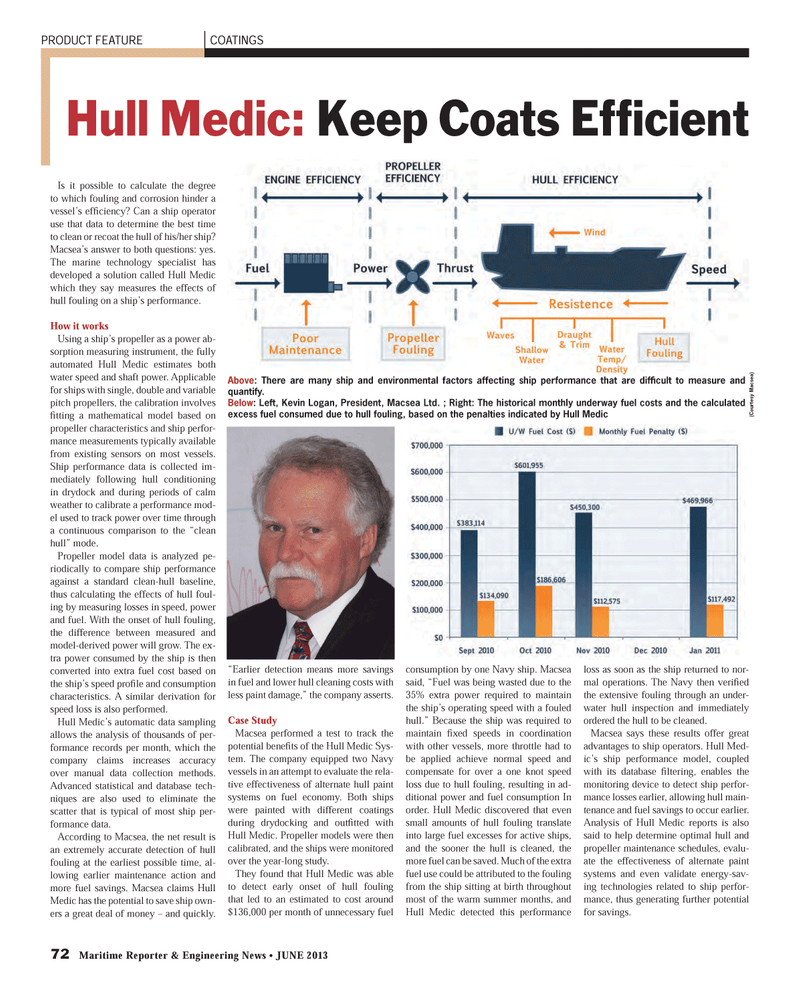
Page 72: of Maritime Reporter Magazine (June 2013)
Annual World Yearbook
Read this page in Pdf, Flash or Html5 edition of June 2013 Maritime Reporter Magazine
72 Maritime Reporter & Engineering News ? JUNE 2013 PRODUCT FEATURE COATINGS Is it possible to calculate the degree to which fouling and corrosion hinder a vessel?s ef Þ ciency? Can a ship operator use that data to determine the best time to clean or recoat the hull of his/her ship? Macsea?s answer to both questions: yes. The marine technology specialist has developed a solution called Hull Medic which they say measures the effects of hull fouling on a ship?s performance. How it worksUsing a ship?s propeller as a power ab- sorption measuring instrument, the fully automated Hull Medic estimates both water speed and shaft power. Applicable for ships with single, double and variable pitch propellers, the calibration involves Þ tting a mathematical model based on propeller characteristics and ship perfor- mance measurements typically available from existing sensors on most vessels. Ship performance data is collected im-mediately following hull conditioning in drydock and during periods of calm weather to calibrate a performance mod-el used to track power over time through a continuous comparison to the ?clean hull? mode.Propeller model data is analyzed pe-riodically to compare ship performance against a standard clean-hull baseline, thus calculating the effects of hull foul- ing by measuring losses in speed, power and fuel. With the onset of hull fouling, the difference between measured and model-derived power will grow. The ex- tra power consumed by the ship is then converted into extra fuel cost based on the ship?s speed pro Þ le and consumption characteristics. A similar derivation for speed loss is also performed.Hull Medic?s automatic data sampling allows the analysis of thousands of per- formance records per month, which the company claims increases accuracy over manual data collection methods. Advanced statistical and database tech-niques are also used to eliminate the scatter that is typical of most ship per- formance data. According to Macsea, the net result is an extremely accurate detection of hull fouling at the earliest possible time, al-lowing earlier maintenance action and more fuel savings. Macsea claims Hull Medic has the potential to save ship own-ers a great deal of money ? and quickly. ?Earlier detection means more savings in fuel and lower hull cleaning costs with less paint damage,? the company asserts.Case StudyMacsea performed a test to track the potential beneÞ ts of the Hull Medic Sys- tem. The company equipped two Navy vessels in an attempt to evaluate the rela-tive effectiveness of alternate hull paint systems on fuel economy. Both ships were painted with different coatings during drydocking and outÞ tted with Hull Medic. Propeller models were then calibrated, and the ships were monitored over the year-long study. They found that Hull Medic was able to detect early onset of hull fouling that led to an estimated to cost around $136,000 per month of unnecessary fuel consumption by one Navy ship. Macsea said, ?Fuel was being wasted due to the 35% extra power required to maintain the ship?s operating speed with a fouled hull.? Because the ship was required to maintain Þ xed speeds in coordination with other vessels, more throttle had to be applied achieve normal speed and compensate for over a one knot speed loss due to hull fouling, resulting in ad-ditional power and fuel consumption In order. Hull Medic discovered that even small amounts of hull fouling translate into large fuel excesses for active ships, and the sooner the hull is cleaned, the more fuel can be saved. Much of the extra fuel use could be attributed to the fouling from the ship sitting at birth throughout most of the warm summer months, and Hull Medic detected this performance loss as soon as the ship returned to nor- mal operations. The Navy then veri Þ ed the extensive fouling through an under- water hull inspection and immediately ordered the hull to be cleaned.Macsea says these results offer great advantages to ship operators. Hull Med-ic?s ship performance model, coupled with its database Þ ltering, enables the monitoring device to detect ship perfor- mance losses earlier, allowing hull main- tenance and fuel savings to occur earlier. Analysis of Hull Medic reports is also said to help determine optimal hull and propeller maintenance schedules, evalu-ate the effectiveness of alternate paint systems and even validate energy-sav- ing technologies related to ship perfor- mance, thus generating further potential for savings.Hull Medic: Keep Coats EfÞ cient(Courtesy Macsea) Above: There are many ship and environmental factors affecting ship performance that are difÞ cult to measure and quantify. Below: Left, Kevin Logan, President, Macsea Ltd. ; Right: The historical monthly underway fuel costs and the calculated excess fuel consumed due to hull fouling, based on the penalties indicated by Hull MedicMR #6 (66-73).indd 72MR #6 (66-73).indd 725/31/2013 10:24:46 AM5/31/2013 10:24:46 AM

 71
71

 73
73
